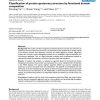145 search results - page 24 / 29 » Predicting DNA-binding sites of proteins from amino acid seq... |
BMCBI
2006
13 years 7 months ago
2006
Background: The number and the arrangement of subunits that form a protein are referred to as quaternary structure. Quaternary structure is an important protein attribute that is ...
BMCBI
2010
13 years 7 months ago
2010
Background: Phosphorylation events direct the flow of signals and metabolites along cellular protein networks. Current annotations of kinase-substrate binding events are far from ...
BMCBI
2010
13 years 7 months ago
2010
Background: The protein folding problem remains one of the most challenging open problems in computational biology. Simplified models in terms of lattice structure and energy func...
BMCBI
2008
13 years 7 months ago
2008
Background: Recent approaches for predicting the three-dimensional (3D) structure of proteins such as de novo or fold recognition methods mostly rely on simplified energy potentia...
BMCBI
2008
13 years 7 months ago
2008
Background: A multiple sequence alignment (MSA) generated for a protein can be used to characterise residues by means of a statistical analysis of single columns. In addition to t...


